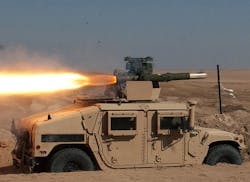Raytheon to build tube-launched TOW anti-tank weapons to provide Army with precisions weapons capability
Officials of the Army Contracting Command at Redstone Arsenal, Ala., are asking the Raytheon Missile Systems segment in Tucson, Ariz., to build the tube-launched, optically-tracked, wireless-guided (TOW) munition to help defend U.S. forces from enemy armored combat vehicles.
The multimission TOW 2A, TOW 2B, TOW 2B aero, and TOW bunker-buster missile is the one of the primary precision weapons for anti-armor, anti-fortification, and anti-amphibious landing used throughout the world today, Raytheon officials say.
TOW missiles can be fired from all TOW launchers, including the Improved Target Acquisition Systems (ITAS), Stryker anti-tank guided missile vehicle (modified ITAS), and Bradley Fighting Vehicles (Improved Bradley Acquisition Subsystem).
TOW tube-launched weapons can be mounted to a wide variety of vehicles, including the Joint Light Tactical Vehicle (JLTV), Humvee, and also can be placed in improvised ground fortifications for front-line infantry use. Versions of the TOW missile also can be fired from Light Armored Vehicle–Anti-tank and U.S. Marine Corps AH-1W Cobra attack helicopter.
If the TOW weapon system remains in service with the U.S. military beyond 2050 as military officials plan today, it will have remained in the Pentagon's arsenal for more than 80 years.
To fire the TOW missile, the operator uses an optical missile sight attached to the launcher. The sight is data linked to the missile. Wireless TOW missiles include an RF transmitter added to the missile case and an RF receiver located inside the missile.
When the missile fires, the RF transmitter in the launcher relays information to the missile while in flight. The operator keeps the sight fixed on the target -- even if the target is moving -- to guide the missile to its target. Original versions of the TOW, which were called the tube-launched, optically-tracked, wire-guided missile, trailed a thin wire that relayed information to the missile from the sight.
TOW is in service in more than 40 international armed forces and integrated on more than 15,000 ground versions, vehicle- and helicopter-mounted versions worldwide, Raytheon officials say.
On these orders Raytheon will do the work in Tucson, Ariz., should be finished by August 2022. For more information contact Raytheon Missile Systems online at www.raytheon.com, or the Army Aviation and Missile Command at paste link here.
Ready to make a purchase? Search the Military & Aerospace Electronics Buyer's Guide for companies, new products, press releases, and videos
